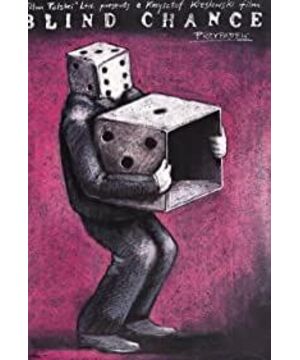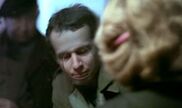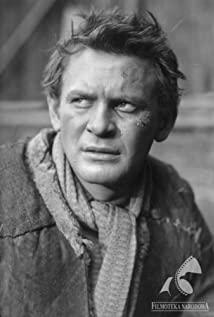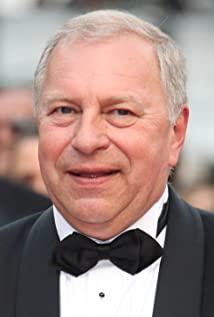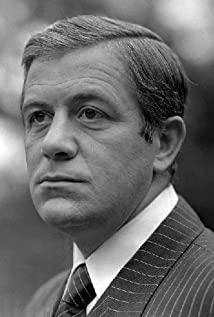A puzzling opening, with a young man roaring, followed by a creepy, low-camera fixed shot at the height of a corpse after the title card for "A Song of Opportunity" in the title sequence, followed by Jump to a little boy, followed by a series of subjective shots. Through slight lens panning, we find that it is not a simple POV of the protagonist, but an illusion full of subjective invitations, and the shots themselves are actually objective With a certain immersive effect, it narrates the situation of the male protagonist with a distance effect, and through a series of incredible dialogues and music, we finally understand in the sixth minute of the film. , the male protagonist is a doctor, his father died, and the male protagonist's father has a great influence on the male protagonist. At this time, he needs a new environment to find new ideals.
So he chose to go to Warsaw, which was Poland in the 1980s. "Good luck", he finally got into the car in time and met an old man in the car. Under half coercion and half decoy, he gloriously became a Our comrade, who eventually became an official, just when he was in crisis, the film suddenly cuts back to the train station, he went back to the train station again, and became a young man again, this time he didn't rush Getting on the train, out of anger, he attacks the police, and a new story unfolds where he becomes an active member of the underground Catholic youth movement, and in future setbacks, the narrative flashes back to his run back to the platform. At that moment, a new story begins again. He returns to medical school and marries a woman he met at the train station.
There are many similar movies, such as "Lola Run" and "The Birth of a Word". These types of movies show their multiple futures one by one, and return to the bifurcation point after each path reaches the end. It is the station that goes to Warsaw. And such multiple future choices and strategic presentations are unreal and artificially arranged, but why are there such types of films?
We have reason to believe that the behavior of human beings watching movies is a kind of psychological behavior. The basis of the active response when watching movies is psychology. The process we use to grasp the world, what we perceive through movies is the The perception of the world rather than the narrative mode of the story, and the artifacts of the narrative in most cases do not affect our understanding of the authoritative understanding of the story for understanding our perception of the world. When understanding a story, our thinking tendency plays a central role. It is a kind of "principle of least deviation". Our cognition of things in the movie will not deviate from our understanding of the presentation of this element in reality. Therefore, in understanding In a plot, we often start from a single event, make judgments based on first impressions, and try to shoot other possibilities to achieve the development we hope. This is why there are always people who are willing to struggle with "how the movie should be made" and "I teach this director how to tell the story and develop the story". This is a consciousness cultivated through long-term life practice and movie watching training, which can be called "routine". A large number of movies are such "routine" movies.
A similar "Song of Opportunity" is produced for our other "counterfactual" thinking, that is, a bifurcated path narrative based on the thinking of "what if it was possible in the first place".
1. The bifurcation path narrative follows a strict causal relationship in each narrative, and because it must be stable, otherwise there will be infinite bifurcations. We found that the "Song of Opportunity" must be because of that train. For this reason, although other characters will appear, the end point of the fork is whether the hand reaches the handle of the carriage that time.
2. Forks are marked. In the story, characters may comment on their multiple futures, such as in the second story where the male protagonist says to the priest "If only I could catch that train", which is something that happens in movies like this It has a reflexive effect. In order to further enhance this kind of announcement of "I am conducting a bifurcated path narrative", the film will naturally set a clear mark to enhance the audience's perception of narrative nodes. "Song of Opportunity" uses freeze-frame shots, the appearance of the same musical accompaniment, and the almost identical shots back when the male protagonist is running at the station, which is very effective in strengthening the audience's cognition of the film's structure.
3. Fork paths eventually cross. This kind of intersection is perceptual, including recurring characters and social issues to be expressed. The three stories of "A Song of Opportunity" are all connected by some broad social movement. Regardless of the protagonist's choice, he All were involved in the unofficial student movement and their samizdat. During his career as a party official, he turned a blind eye to the movement; as a Catholic, he became an activist; as a doctor, he became a scapegoat for his mentor's son, The tutor's son was fired for being involved in the student movement. Such recurring events reinforce the theme that in a revolutionary period like that, no one can stay out of it, and in a revolution we should also fear its coerciveness in addition to enthusiasm. The second makes the different multiple futures have more considerable cognitive coherence through the recurring characters and narrative background.
4. The bifurcation path is not a narrative that is completely equally stressed. The three runs of the male protagonist in catching the train are getting shorter and shorter, although for the protagonist, each time is a new beginning. As the audience, we are already in The background information was learned in the previous repetitions, and the choice of the protagonist is being exhausted, so for the information that has been learned, the method of omission is often adopted.
5. The final path. If the first path is the closest to our conception of classical narrative conventions, the last path tends to presuppose earlier stories as preconditions for the last, and to suggest that the last future seems to be the truest and most convincing Satisfied ending, and thus in a prominent position. At the end of the film, the protagonist boarded a plane to go to Paris, and then the plane exploded in mid-air. With the hoarse roar at the beginning, we can guess that the beginning is actually the last moment of his life. The film forms a loop structure. The calm pace paints us a picture of Polish society in the 1980s and the tragic color of the characters. No matter what we choose, each of us is unavoidable in such an era and will be involved in politics, even if it is The same is true of an apolitical choice, in times like that, we will eventually be doomed. The title of the film is "Song of Opportunity", which is extremely ironic. All the seemingly opportunities are just a futile struggle. Another title, "Blind Typing", is more interesting. The absurdity of the protagonist's experience is that Time and again "adventures" were involved in incidents in blind hits and misses, and the ending was always tragic. Just as at that time Poland, from the Nazis to the Soviet Union, was drowned in the rolling waves in the struggle again and again. Blind-hitting and staggering alone.
View more about Blind Chance reviews


